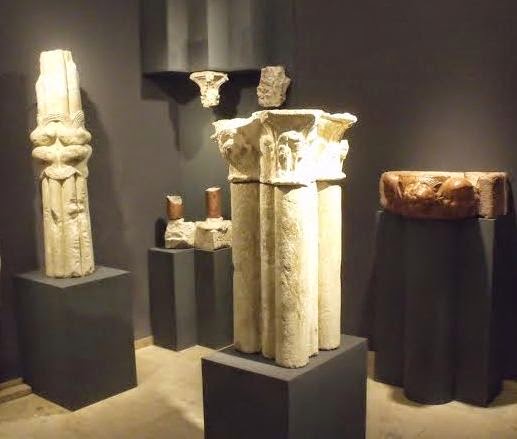As this blog is aimed for an international audience, I generally only write reviews of books published in English or other western languages. However, in this post I would like to call attention to a few books published mostly in Hungarian last year.
János Eisler: Kis könyv a Szent Koronáról (Small book on the Holy Crown of Hungary). Budapest, 2013
This monograph, written by an art historian - a long-time curator of the Museum of Fine Arts - is a welcome addition to the literature on the Crown of St Stephen. Not too much in detail has been written about this unique object in recent years - a basic bibliography is available on
my webpage dedicated to the Hungarian coronation insignia. Unfortunately, the subject of the crown has been hijacked by authors far removed from the framework of scholarship, putting forward one crazy theory after the other about the supposed age and power of the crown. János Eisler, however, concerns himself with the actual historical, political and theological questions of 11-12th century Hungary: the period when the crown was created. I am looking forward to reading it.
Középkori egyházi építészet Erdélyben - Medieval Ecclesiastical Architecture in Transylvania, vol. 5. Edited by Péter Levente Szőcs. Satu Mare, 2012.
This is the fifth volume in a series of
conference proceedings, edited by Péter Levente Szőcs, and published by the
County Museum of Satu Mare. As was the case with the previous volumes, the subject matter ranges from Romanesque architecture to late gothic church furnishings, in this case from four-lobed Romanesque churches to the rood screen of the parish church of Szeben/Sibiu and the wall paintings of Segesvár/Sighisoara. One study I found particularly interesting is Radu Lupescu's analysis of the western portal of the Church of St. Michael in Kolozsvár/Cluj, featured on the cover of the book. The studies are published in various languages: Hungarian, Romanian, English and French, with summaries generally in English. The list of studies can be consulted
here. The book was published with the support of a EU-funded Hungarian-Romanian cross-border research project, about which you can read on the
project website (Patronimium2).

A szórvány emlékei (Monuments of the diaspora). Ed. Tibor Kollár. Budapest, Teleki László Alapítvány, 2013.
This is another, much more lavishly produced book on medieval architecture in Transylvania. The book aims to publish medieval churches which had been abandonded by their original builders (Hungarians and Transylvanian Saxons) in southern Transylvania, due to historical circumstances. In addition to architecture, the book also focuses on medieval wall-painting, mainly on newly discovered monuments. The books makes available a whole new set of material for researchers of medieval art, not just in the studies but also in the large number of brand new photographs. The book was edited by Tibor Kollár, who became known as the organizer and editor of a
series of books on Hungarian medieval architecture. The contents of the present volume are listed (in Hungarian) on the
publishers website. My study in the book can be read
here (a summary is available right
here on the blog).
Közös tér - Közös örökség. Common space - Common heritage. Edited by József S. Sebestyén. Budapest, 2013.
This bilingual book documents the results of a long-term project funded by the Hungarian government, aimed at restoring monuments of mainly medieval Hungarian architecture from regions outside of the borders of modern Hungary. In ten years an amount of roughly 7,5 million dollars was spent on restoring approximately 300 architectural monuments related to Hungarian cultural history. Subsidies were mainly directed towards archeological studies, professional conservation, restauration and preservation efforts, but also included at times funding earmarked for making future use of monument buildings possible. This book, which grew out of an
exhibition series, present this work, seeking to offer a glimpse into the wealth of architectural monuments bearing witness to the cultural history of centuries past.
Dániel Pócs: Didymus-corvina - Hatalmi reprezentáció Mátyás király udvarában (The Didymus Corvina - Representation of power at the court of king Matthias Corvinus). Budapest, 2013.
Dániel Pócs, one of the researchers who participated in the organization of last years Florentine exhibition dedicated to
art at the court of Matthias finally published a book based on his doctoral dissertation, the subject of which is political iconography at the court of Matthias. The starting point of his analysis is one of the most splendid manuscripts commissioned by the king, the Didymus Corvina (New York, Pierpont Morgan Library,
MS M.496). The book is an important addition not only to Corvina-studies, but also to art history of the Matthias period in general. An earlier study of Pócs on the manuscript is available in English as well: Pócs, Dániel: "Holy Spirit in the Library. The Frontispiece of the Didymus corvina and neoplatonic theology at the court of king Matthias Corvinus", in:
Acta Historiae Artium, 41, 1999/2000, pp. 63-212.
See some of the other books I reviewed or reported on previously:
.jpg)








.jpg)
.jpg)







_7.jpg)























